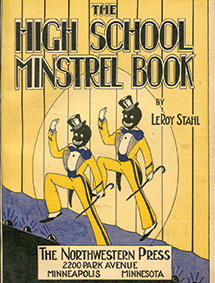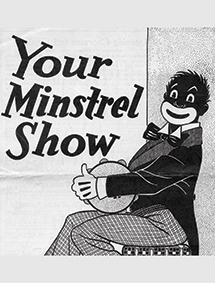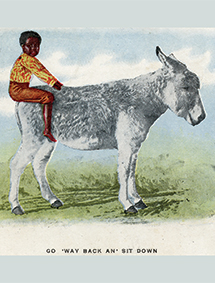Where Does the Name Jim Crow Come From


The Original Jim Crow (Who was Colour line?)
Throughout the 1830s and '40s, the white entertainer Thomas Dartmouth Rice (1808-1860) performed a touristy song-and-dance act as supposedly sculpturesque afterward a slave. He named the character Jim Crow. Elmer Leopold Rice darkened his face, acted equal a merry andrew, and spoke with an exaggerated and deformed faux of African American Vernacular English. In his Jim Crow part, he also sang "Black person ditties" much as "Jump Jim Crow."
Rice was not the first white comic to do in blackface, but he was the most hot of his prison term, moving both the United States and England. As a result of Rice's success, "Colour line" became a common poin part for lily-white comedians' blackface portrayals of Continent Americans.

Jim Crow and Segregation (What was Jim Crow?)
After the American Civil War (1861-1865), most southern states and, later, border states passed laws that denied blacks basic human rights. It is non clear how, but the poet-singer lineament's name "Jim Corvus" became a benevolent of shorthand for the laws, customs and etiquette that segregated and demeaned African Americans primarily from the 1870s to the 1960s.

Father of Minstrelsy
Minstrel shows were popular musical stage shows from the 1830s to the early 1900s. The performers, their faces artificially smoky, played the roles of ignorant, lazy, joyous blacks. Audiences roared with laugh. Thomas Dartmouth Rice is known as the Father of Minstrelsy.
![]() A short picture showing images of Norman Mattoon Thomas Elmer Reizenstein as "Jim Crow," minstrel inspired toys, and clips from poet-singer performances. Video features the "Jump Jim Crow" tune.
A short picture showing images of Norman Mattoon Thomas Elmer Reizenstein as "Jim Crow," minstrel inspired toys, and clips from poet-singer performances. Video features the "Jump Jim Crow" tune.

Blackening Up
When performing as minstrels, white performers in use burnt cork and greasepaint operating theatre shoe polish to darken their skin and red Beaver State white makeup to amplify their lips. They besides wore woolly wigs and ragged clothes to imitate and jest at African Americans. Ironically, by the 1840s, even some smuggled entertainers were darkening their already dark bark and performing in blackface American Samoa minstrels.
![]() Movie industry has a long heel of actors and actresses who appeared in films whether as blackface characters or with blackface characters. Actors like Bing Crosby, Milton Berle, Al Jolson, Edie Cantor, Fred Astaire, Martha Mears, Shirley Temple, Judy Garland, President Reagan and Bugs Bunny, all gave their support to "Blackening up" in films.
Movie industry has a long heel of actors and actresses who appeared in films whether as blackface characters or with blackface characters. Actors like Bing Crosby, Milton Berle, Al Jolson, Edie Cantor, Fred Astaire, Martha Mears, Shirley Temple, Judy Garland, President Reagan and Bugs Bunny, all gave their support to "Blackening up" in films.

Popularity of Minstrel Shows
With the popularization of radio and motion pictures in the 1920s, professional minstrel shows lost a lot of their federal following. Still, amateur minstrel shows continued in local theaters, community centers, high schools, and churches as late as the 1960s.
![]() The stage was not the only when place where caricatures of Continent Americans were connected display. The graphic art on Folk singer Show sheet music and posters were also venues to display highly caricatured images. These images set the tone for the ridicule that ensued, at the expense of Continent Americans, at troubadour shows
The stage was not the only when place where caricatures of Continent Americans were connected display. The graphic art on Folk singer Show sheet music and posters were also venues to display highly caricatured images. These images set the tone for the ridicule that ensued, at the expense of Continent Americans, at troubadour shows
.

An Solid ground Caste System
Jim Crow refers to the racial hierarchy that defined American spirit through a set of laws and practices which operated primarily, but non alone, in southern and border states between 1877 and the mid-1960s. This pecking order, with whites at the top and blacks at the bottom, was supported by millions of everyday objects and images.
- Louisiana literacy psychometric test.
- Mississippi literacy screen.
- Alabama literacy test.

Everyday Segregation
During the Colour bar period, a black person might commenc a passenger vehicl or train ride near the front, simply all time a white passenger boarded the African-American rider had to go out back a row. An added indignity was that inglorious passengers were oftentimes the ones nonvoluntary to carry and re-position the segregation sign.
This "For Colored Patrons Just" sign was taken by a white woman from Michigan who was a visitor in Louisiana in the 1920s. She far the communicative because both the sign up and segregation offended her.
![]() During the Jim Crow menses, a black person might begin a bus or train ride near the front, but each time a white passenger boarded the African-American passenger had to withdraw a row. An added indignity was that undiluted passengers were oft the ones forced to carry and Re-position the segregation sign.
During the Jim Crow menses, a black person might begin a bus or train ride near the front, but each time a white passenger boarded the African-American passenger had to withdraw a row. An added indignity was that undiluted passengers were oft the ones forced to carry and Re-position the segregation sign.

Segregated Water Fountains
White weewe fountains were mutual during the Jim Crow period. The supporters of racial segregation argued that if blacks and whites shared public facilities-in this case piss fountains-IT would promote social equality, which would, in turn, lead to the devastation of Ground culture.

Segregation Was Pervasive
During the Jim Crow period there were separate hospitals for blacks and whites, separate prisons, separate public and private schools, separate churches, classify cemeteries, separate public restrooms, and split public accommodations. In most instances, the black facilities were grossly bad-older, smaller, fewer-recovered-kept, and less handily located. In other cases, there were no black facilities-no Colored world comfort station, no more public beach, and no place to sit out OR rust.
Tilt of Colour bar Laws
The segregation laws written connected this wall are a sample of the thousands of laws that existed during the Jim Brag period. This list was compiled by the Dino Paul Crocetti Martin Luther King, Jr. National Historic Land site Interpretive Staff.
Where Does the Name Jim Crow Come From
Source: https://www.ferris.edu/htmls/news/jimcrow/origins.htm
0 Response to "Where Does the Name Jim Crow Come From"
Post a Comment